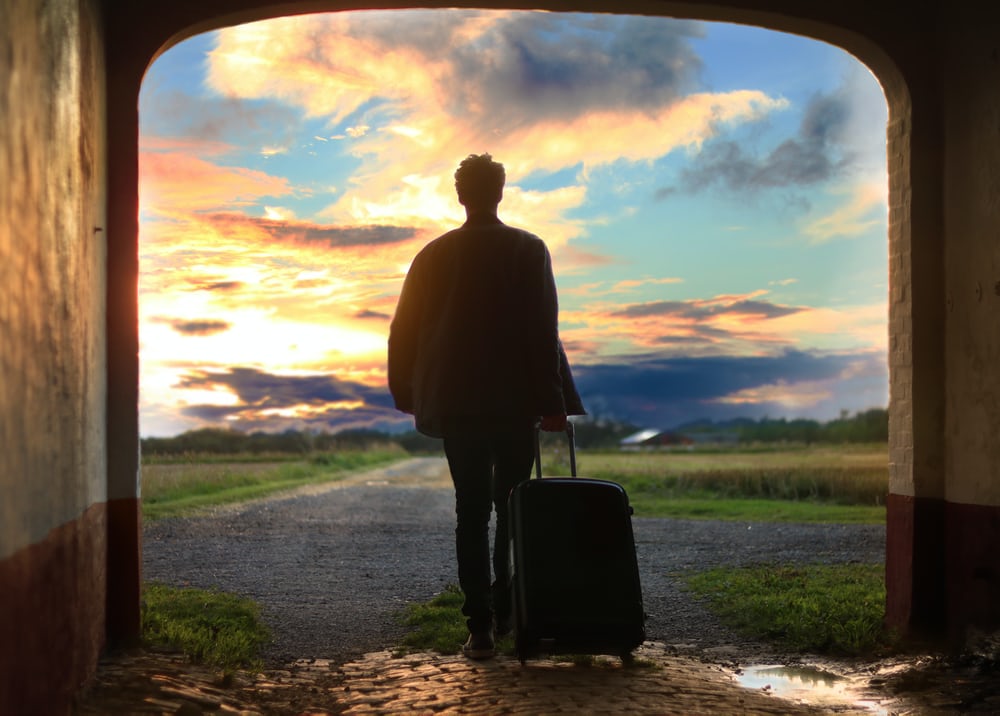That’s It My self-imposed limit is 20 pounds in a 9″ × 21″ × 14″ carry-on-size bag (it’ll fit in your airplane’s overhead bin, at least on your transatlantic flight — though many European airlines restrict hand luggage to even smaller weights and dimensions). I will admit that along the way I have mailed things back or on my last leg of a trip I have bought an additional bag for the return.
When you carry your own luggage, it’s less likely to get lost, broken, or stolen. Quick, last-minute flight changes become simpler. A small bag sits on your lap on the bus or taxi and stashes easily overhead on an airplane.
Clothing Shirts/blouses. Bring up to five short-sleeved or long-sleeved shirts or blouses (how many of each depends on the season) in a cotton/polyester blend. Shirts with long sleeves that roll up easily can double as short-sleeved. Look for a wrinkle-camouflaging pattern or blended fabrics that show a minimum of wrinkles. Synthetic-blend fabrics (such as Coolmax or microfiber) often dry overnight.
Pants/shorts. Bring two pairs: one lightweight cotton and another super-lightweight pair for hot and muggy big cities. Jeans can be too hot for summer travel (and are slow to dry). Many travelers like lightweight convertible pants/shorts with zip-off legs. While not especially stylish, they’re functional in Italy, where you can use them to cover up inside churches while still beating the heat outside. Button-down wallet pockets are safest (though still not nearly as thief-proof as a money belt). If you bring shorts, one pair is probably enough. Shorts can double as a swimsuit for men when swimming in lakes or the sea.
Underwear and socks. Bring five sets (lighter dries quicker). Bamboo or cotton/nylon-blend socks dry faster than 100 percent cotton, which lose their softness when air-dried. Shoes. Bring one pair of comfortable walking shoes with good traction. Mephisto, Ecco, and Rieker look dressier and more European than sneakers, but are still comfortable. Sturdy, low-profile tennis shoes with a good tread are fine, too. For a second pair, consider sandals in summer. Flip-flops are handy if you’ll be using bathrooms down the hall. Whichever shoes you bring, make sure they are well broken in before you leave home.
Sweater or lightweight fleece. Warm and dark is best — for layering and dressing up. I shawl or pashmina is great for the plane.
Jacket. Bring a light and water-resistant windbreaker with a hood. Neutral colors used to look more European than bright ones, but now everything from azure blue to pumpkin orange has made its way into European wardrobes. A hooded jacket of Gore-Tex or other waterproof material is good if you expect rain. (For summer travel, I wing it without rain gear — but always pack for rain in Britain and Ireland.)
Tie or scarf. For instant respectability, bring anything lightweight that can break the monotony and make you look snazzy.
Swimsuit. To use public pools, you’ll need a swimsuit (men can’t just wear shorts; and in France, men need to wear Speedo-type swimsuits — not swim trunks).
Sleepwear/loungewear. Comfy streetwear — such as shorts, leggings, T-shirts, tank tops, yoga pants, and other lightweight athletic gear — can be used as pajamas, post-dinner loungewear, and a modest cover-up to get you to the bathroom down the hall.
Documents, Money, and Travel Info Money belt (or neck wallet). This flat, hidden, zippered pouch — worn around your waist (or like a necklace) and tucked under your clothes — is essential for the peace of mind it brings. You could lose everything except your money belt, and the trip could still go on.
Money. Bring your preferred mix of a debit card, a credit card, and an emergency stash of hard US cash (in $20 bills). Always have a hidden stash of money just in case you lose your money along with a photo copy of your passport and your credit cards. If stopped in a foreign country always give them the photo copy never the original.
Documents. Bring your passport; plane, train, and rental car documents or vouchers; driver’s license; and any other useful cards (student ID, hostel membership card, and so on). Photocopies and a couple of passport-type photos can help you get replacements more quickly if the originals are lost or stolen. In your luggage, pack a record of all reservations (print out your hotel confirmation emails). Bring any necessary contact info if you have health or travel insurance. I photograph everything and mail it to myself as an extra precaution.
Guidebooks and maps. Pack the travel info you’ll need on the ground (or download it into your ereader). I like to rip out appropriate chapters from guidebooks and staple them together, or use special slide-on laminated book covers.
Small notepad and pen. A tiny notepad in your back pocket or day pack is a great organizer, reminder, and communication aid.
Journal. An empty book to be filled with the experiences of your trip will be your most treasured souvenir. Attach a photocopied calendar page of your itinerary.
Small day pack. A lightweight pack is great for carrying your sweater, camera, guidebook, and picnic goodies while you leave your large bag at the hotel or train station. Don’t use a fanny pack — they’re magnets for pickpockets. Toiletries and Personal Items Toiletries kit. Because sinks in many hotels come with meager countertop space, I prefer a kit that can hang on a hook or a towel bar. Before cramming it with every cosmetic item you think you might use, ask yourself what toiletries you can live without for a short time. For your overseas flight, put all squeeze bottles in sealable plastic baggies, since pressure changes can cause even good bottles to leak. Pack your own bar of soap or small bottle of shampoo if you want to avoid using hotel bathroom “itsy-bitsies” and minimize waste and garbage. I use zip lock bags for everything. I label the outside of the contents of each enclosed plastic bottle.
Medicine and vitamins. Even if you check your suitcase on the flight, always carry on essential toiletries, including any prescription medications (don’t let the time difference trick you into forgetting a dose). Keep medicine in original containers, if possible, with legible prescriptions.
First-aid kit. This includes items such as sun screen, neosporin, hand sanitizer, bandaids, Imodium, Digel. Most of these items you can buy in most places in the world but its important to be prepared.
Glasses/contacts/sunglasses. Contact-lens solutions are widely available in Europe. Carry your lens prescription, as well as extra glasses, in a solid protective case. If it’s a sunny season, pack along sunglasses, especially if they’re prescription. I always take 2 pairs of sun glasses and reading glasses as these happen to disappear while traveling.
Sealable plastic baggies. Bring a variety of sizes. In addition to holding your carry-on liquids, they’re ideal for packing leftover picnic food, containing wetness, and bagging potential leaks before they happen. The two-gallon jumbo size can be used to pack (and compress) clothing or do laundry. Bring extras for the flight home.
Laundry soap. A tiny box of detergent or a plastic squeeze bottle of concentrated, multipurpose, biodegradable liquid soap is handy for laundry. I find hotel shampoo works fine as laundry soap when I’m doing my wash in the sink. For a spot remover, bring a few Shout wipes or a dab of Goop grease remover in a small plastic container.
Small washcloth or face cleansing wipes.
Sewing kit. Clothes age rapidly while traveling. Add a few safety pins and extra buttons. Small packet of tissues. Stick one of these in your day pack, in case you wind up at a bathroom with no toilet paper.
Travel alarm/wristwatch. Make sure you have an alarm to wake yourself up (your smartphone, a little clock, etc.). At budget hotels, wake-up calls are particularly unreliable. I have Tmobile which lets you use the google translator and google maps along with free text and email from most countries. In Mexico and Canada you can also have free phone calls.
Earplugs. If night noises bother you, you’ll love a good set of expandable foam plugs. They’re handy for snoozing on trains and flights, too. I prefer the gel earplugs and I also take Eye Mask.
Hairdryer. These are generally provided in $100-plus hotel rooms. If you can’t risk a bad-hair day, buy a cheap, compact hairdryer in Europe or bring a travel-friendly one from home.
Electronics
Smartphone/mobile phone. Bring your smartphone to keep in touch with folks back home and for accessing resources on the road such as email, travel apps, and GPS. If you just want to make calls or send texts. I sometimes take a second phone and buy a sim card from the country I am visiting.
Digital camera. Take along an extra memory card and battery, and don’t forget the charger and a cable for downloading images.
Tablet, ereader, or portable media player. Download apps, ebooks, and music before you leave home.
Laptop. If you’ve got a lot of work to do, or want to keep your photoblog updated, a laptop can be worth the weight.
USB flash drive. If you’re traveling with a laptop, a flash drive can be handy for backing up files and photos. As an alternative, consider free cloud storage sites — such as Amazon Cloud Drive, Apple iCloud, or Dropbox — that you can access anywhere.
Headphones/earbuds. These are a must for listening to music, tuning in to audio tours, or simply drowning out whiny kids on the plane. (I never travel without my noise-canceling Bose headphones.) Bring a Y-jack so you and a partner can plug in headphones at the same time.
Chargers and batteries. Bring each device’s charger, or look into getting a charger capable of charging multiple devices at once. A ziplock bag is handy here to keep all your cords in one place. My suggestion is always take an extra phone charger cord. I also would take a portable charger for your telephone.
Adapters for the country you are visiting. You can buy an overall adapter that can be adjusted per country. This is a necessity and you will need an adapter for each item you are planning to charge.
I discovered on my last trip how important it is to have luggage trackers on your luggage. My friends luggage was left in Cairo and with his tracker was able to know the exact location. Apple has their own trackers or you can buy http
s://www.tile.com/

